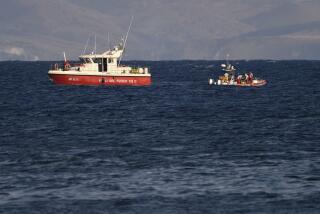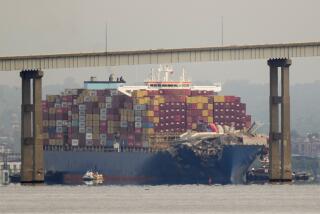Capsized Costa Concordia slowly being righted
GIGLIO, Italy -- Twenty months after it capsized off the Italian coast, killing 32 people, the Costa Concordia cruise ship slowly emerged from the sea Monday as a painstaking $800-million salvage effort got underway.
With 56 giant pulleys starting to heave the half-submerged vessel back to an upright position, the rust mark at its waterline rose into view as the tilted ship slowly shifted, revealing yards of metalwork blackened by months underwater.
The 950-foot-long, 114,000-ton vessel has been impaled on two underwater granite outcrops since January 2012, when it grounded after Captain Francesco Schettino smashed the ship into rocks while attempting a âsail pastâ maneuver close to the island. Schettino is currently standing trial on charges of manslaughter and abandoning his ship.
PHOTOS: Capsized Costa Concordia being righted
About 4,200 passenger and crew were forced to scramble into lifeboats or plunge into shallow water after the ship ran aground. Thirty-two people drowned, some of them sucked under by whirlpools created as the ship tilted.
The Costa Concordia is the biggest ship ever to be hoisted back upright after capsizing. The technique, known as parbuckling, has been used in the past, notably on warships, including the battleship Oklahoma, which was parbuckled by the U.S. military in 1943 after it was bombed during the 1941 attack on Pearl Harbor.
After months of careful preparation, during which six underwater platforms were built for the cruise ship to be righted onto, Mondayâs operation was postponed by three hours from its scheduled 6 a.m. start after a violent electrical storm battered the Tuscan island overnight, which delayed last-minute checks.
But shortly after noon, the ship was finally wrenched free from the two granite outcrops, signaling that the operation to right the stricken vessel was proceeding as planned.
âImages show the lifting is happening as planned,â said Italian civil protection agency chief Franco Gabrielli.
Sergio Girotto of the Italian firm Micoperi, which has teamed with U.S. company Titan on the salvage operation, said the ship had been raised three degrees by midday, a fraction of the 65 degrees that will make it sit upright on the underwater platforms.
Engineers started the operation by applying bursts of pressure on the pulleys, which are attached to the underwater platforms and to towers on the landward side of the ship.
Girotto said that the ship pulled free of the rocks, which had penetrated 18 feet into the hull, once the pulleys had built up 6,000 tons of pressure. At noon, the ship was standing on its edge, off of the outcrops but not yet onto the platforms.
Next, 11 massive metal boxes, some the height of 11-story buildings, which are welded to the exposed side of the ship, are due to touch the water. The boxes, known as sponsons, will initially provide buoyancy, slowing the shipâs rotation in the water.
Salvage workers based in a floating control center on a barge off the bows of the ship will open valves in the tanks to allow water in, adding weight to bring the ship down onto the platforms.
The entire operation is expected to last 12 hours, ending by about 9 p.m. local time.
Marine biologist Giandomenico Ardizzone, who has been monitoring the seabed for the shipâs operator, Costa Crociere, noted that the vessel will be moved from rocks sloping upward to the shore to platforms deeper in the water, about 100 feet down.
âEveryone expects the ship to rise up, but it will appear the opposite,â he said. âOnce it is settled, the water will rise up to Deck 7 [of the ship], which is almost at the bridge.â
Once the ship is stable, flotation tanks will be added to the formerly submerged side of the ship and it will be refloated and towed next spring to a port, probably on the Italian mainland, for breaking up.
In the run-up to the salvage operation, more than 1 million gallons of water was removed from the food storage area and laundry areas of the ship. âThose were the two parts of the ship that our samples showed were the most polluted. Now the water down there is much cleaner,â Girotto said.
ALSO:
Kerry: Military option in Syria âstill on the tableâ
U.N. finds âclear and convincing evidenceâ of Syria chemical attack
Israel has 80 nuclear warheads, can make 115 to 190 more, report says
More to Read
Sign up for Essential California
The most important California stories and recommendations in your inbox every morning.
You may occasionally receive promotional content from the Los Angeles Times.










